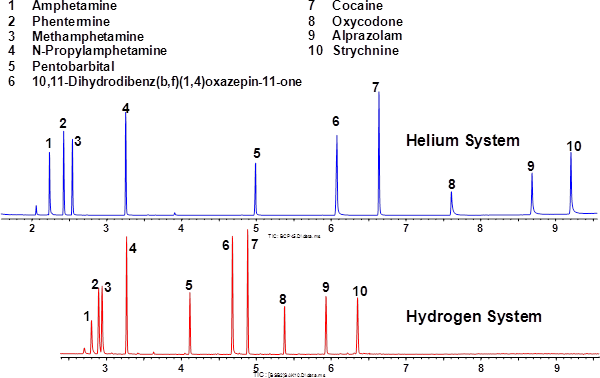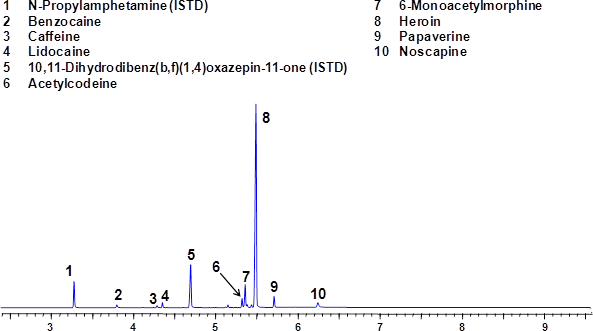Access Agilent eNewsletter, January 2014
>> Update My Profile | Subscribe to Access Agilent | Article Directory
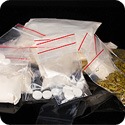
Confident identification of confiscated drugs with the new Agilent Controlled Substances Analyzer
By Craig Marvin
Agilent GPD Solutions Business Manager
Law enforcement depends on forensic laboratories to identify not only the major component of confiscated samples, but also any other relevant compounds that are present at lower levels. These samples range from tablets or unidentified white powder... to botanical material or syringes... to charred pipe residues. Typically, forensic chemists use full scan GC/MS with library match reports generated through database searches to identify controlled substances and pharmaceutical targets.
Drug sample analysis presents a number of challenges
Because the evidence obtained by law enforcement encompasses an expanding array of analytes extracted from simple to complex cutting matrices, analysts must apply greater attention to detail in order to identify controlled substance targets. The appearance of new novel psychoactive substances (NPS) and synthetic cannabinoids presents a number of difficult challenges. These new sample types not only require more complex and expensive sample extraction, but also contain isomers and analogs that must be differentiated from classical drug targets by time-consuming routine database searching methods. In addition, laboratories face increasing operating costs due to the rising price of helium, the carrier gas of choice for GC/MS analysis.
Coupled with a complex analysis and rising operational costs, analysts now face increased financial restraints that force forensic laboratories to deploy fewer resources to analyze this expanding list of emerging drugs.
Improve cost and operational efficiency with the new Agilent Controlled Substances Analyzer
Traditional library searches through Probability Based Matching and manual confirmation require considerable manual labor for compound identification. The new Agilent Controlled Substances Analyzer with Capillary Flow Technology (CFT) uses Deconvolution Reporting Software (DRS) coupled with the precise retention time control through Retention Time Locking (RTL) to provide more efficient data processing and analysis. DRS distinguishes between closely related compounds, allowing analysts to identify trace amounts of target compounds – even in complex samples. These automated tools provide a more efficient, consistent analysis, and expeditious reporting of results – while reducing the potential for human error and bias.
Using hydrogen as a carrier gas for GC/MS presents a viable, less expensive alternative to helium. Transition to hydrogen carrier gas shortens analytical run times and system cycle times, when system hardware is adapted to support fast temperature ramps and rapid oven cool down. Equipping the new Controlled Substances Analyzer with CFT backflush removes the high molecular weight, matrix components to further reduce run time, prevent ghost peaks in subsequent chromatograms, and reduce the frequency of column maintenance.
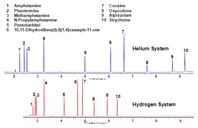 Enlarge
Enlarge
Figure 1. Chromatograms of checkout mix on current helium system (top) and new hydrogen system (bottom).
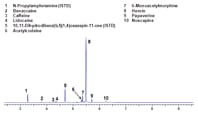 Enlarge
Enlarge
Figure 2. TIC chromatogram from a typical street heroin sample using the new hydrogen system.
Identify controlled substances quickly and accurately
Working in conjunction with NMS Labs in Willow Grove, Pennsylvania, we generated a database of mass spectra using an Agilent 7890B GC with 5977B Mass Spectrometer configured with an Ultra Inert treated flow path, an Agilent J&W DB-5ms Ultra Inert analytical column with CFT back flush and hydrogen carrier gas. Figure 1 depicts improvements in analysis time for the checkout mix using the new hydrogen system versus the current helium analyzer.
The new database contains 461 compounds, including 276 emerging drugs such as synthetic cannabinoids, bath salts, and new psychoactive species. Spectra from extracted reference standards were verified by comparison to NIST11 and an in-house database maintained by NMS. Data were collected using an RTL method to ensure precise database retention times. Mass spectra extracted through AMDIS deconvolution produced clean spectra, with interferences from column bleed and overlapping impurities removed. When available, each database entry includes a CAS#, the chemical formula, precise retention time in minutes, and the compound name.
Based on the above classifications, three hundred eighty-four case samples analyzed on a helium system in use at NMS were reanalyzed using the Controlled Substances Analyzer with hydrogen carrier gas. Samples originally dissolved in methylene chloride were evaporated to dryness at room temperature and reconstituted to volume in ethyl acetate to eliminate potential formation of HCl – and the related inlet and column problems that may arise when using methylene chloride with hydrogen carrier gas. This testing represented over 1,200 individual drug findings, ranging from routine drugs to identification of newer synthetic compounds.
Street heroin samples typically contain a number of adulterants and by-products of synthesis, including 6-monoacetylmorphine (6-MAM), papaverine, and acetylcodeine. Figure 2 depicts chromatography for a typical street heroin sample. Figure 3 shows the DRS database report for a typical street heroin sample.
Amount (ng) |
NIST |
|||||||
|---|---|---|---|---|---|---|---|---|
Retention Time |
CAS # |
Compound Name |
Chemstation |
AMDIS |
Match |
Retention Time Difference (sec) |
Reverse Match |
Hit Number |
3.2850 |
51799327 |
N-Propylamphetamine |
99 |
-0.4 |
90 |
1 |
||
3.8059 |
94097 |
Benzocaine |
100 |
-0.5 |
95 |
2 |
||
4.2958 |
58082 |
Caffeine |
100 |
-0.4 |
91 |
1 |
||
4.3613 |
137586 |
Lidocaine |
99 |
-0.4 |
92 |
1 |
||
4.7037 |
3158858 |
10,11-Dihydrodibenz (b,f) (1,4) oxazepin-11-one |
97 |
0.2 |
93 |
1 |
||
5.3308 |
6703271 |
Acetylcodeine |
100 |
-0.2 |
95 |
1 |
||
5.3687 |
2784738 |
6-Monoacetylmorphine |
100 |
0.2 |
95 |
1 |
||
5.4999 |
561273 |
Heroin |
100 |
0.9 |
97 |
1 |
||
5.7215 |
58742 |
Papaverine |
98 |
-0.2 |
94 |
1 |
||
6.2532 |
128621 |
Noscapine |
92 |
-0.5 |
90 |
1 |
||
Figure 3. DRS report from a street heroin sample run on the new hydrogen system.
A relatively new trend in drug chemistry, synthetic cannabinoids generally have one of a few basic structures, such as naphthylindole, to which variations and substitutions are made to produce a “new” drug. Because the structures are very similar and samples can contain multiple isomers, retention time is important to the proper identification of synthetic cannabinoids. Table 1 summarizes the case data for the positive identification of synthetic cannabinoids. In some cases, data provided positive identification where the current helium system did not find the target compound.
Compound: Synthetic Cannabinoids |
Total Number of Cases Analyzed |
Number of Positive Findings on Hydrogen |
Number of Positive Findings on Helium |
|---|---|---|---|
5-F-PB-22 |
2 |
2 |
2 |
AM-2201 |
1 |
1 |
1 |
JWH-018 |
4 |
4 |
4 |
JWH-022 |
1 |
1 |
0 |
JWH-250 |
3 |
3 |
2 |
PB-22 |
4 |
4 |
4 |
RCS-4 |
1 |
1 |
0 |
UR-144 |
1 |
1 |
0 |
URB-597* |
1 |
1 |
1 |
URB-754 |
1 |
1 |
1 |
XLR-11 |
2 |
2 |
2 |
*Known artifact formation
Table 1. Positive identification of synthetic cannabinoids using the current helium system and new hydrogen system.
Save time and improve performance
The use of hydrogen carrier gas and DRS provides two important ways for the criminalist laboratory to reduce cycle time and data processing time. Compared to the current helium system, the new hydrogen analyzer reduced cycle time from 21 minutes to 13 minutes. With DRS, data analysis time for simple sample data processing was cut in half. For complex samples, DRS reduces labor intensive, manual data review and the potential for false negatives – an important consideration for the presentation and defense of data in criminal cases.
Put the new Controlled Substances Analyzer to work in your lab
You can enjoy the same time and money-saving efficiencies in your lab. Take a moment now to learn more about how Agilent’s new Controlled Substances Analyzer with CFT Backflush and DRS can reduce analysis time, improve results, and save you money.
For Forensic Use.
>> Update My Profile | Subscribe to Access Agilent | Article Directory
